When are SuDS required?
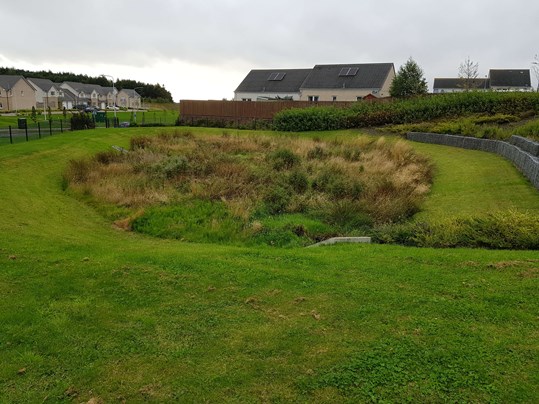 Detention basin in new development
Detention basin in new developmentSince April 2015, SuDS have been a statutory requirement on all Major development.
This means SuDS are required for:
- residential developments of 10 dwellings or more,
- residential developments of 0.5 hectares or more,
- developments where the building floor space to be created is 1,000 square metres or more,
- developments on sites with an area of 1 hectare or more,
- winning and working of minerals of the use of land for mineral-working deposits,
- waste developments.
Further policies on SuDS and green infrastructure may be set out in Local Plans for each of the former districts in Somerset. See the pages on Local policy in Somerset for more information.
For residential dwellings of less than 10 dwellings or other minor developments, SuDS are strongly encouraged. Find out more and see the standing advice on Minor developments.
For more information on SuDS in minerals and waste sites, and major infrastructure see Planning SuDS for different types of development.
Planning and SuDS overview

Outline application
 Water incorporated into housing development (Kingsbrook, Aylesbury)
Water incorporated into housing development (Kingsbrook, Aylesbury)An outline planning application is used to determine whether a development is likely to be approved by the planning authority. The aim is to secure approval in principle, before a fully detailed proposal is submitted.
An outline drainage strategy, plans and drawings should be provided. The LLFA must be satisfied that the drainage proposals are viable and will meet Somerset's local SuDS standards, national SuDS standards and planning policy.
As well as managing the quantity of surface water, the strategy must also demonstrate how the site will meet Somerset's standards on water quality, biodiversity, climate change, amenity, health and safety. It must also set out an agreement in principle for who will adopt and maintain the SuDS, and an outline Maintenance and Operation Plan.
Full details of the national and local requirements for Outline Planning Permission can be found in the Major Application SuDS Checklist and the Somerset local SuDS standards and accompanying guidance.
Full application
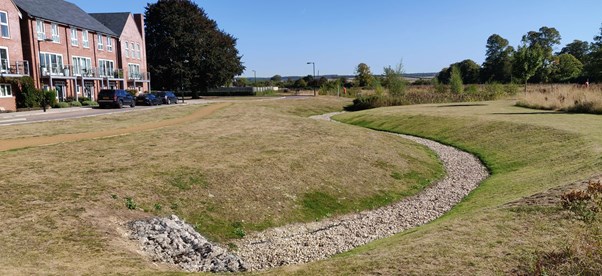 Swale in housing development
Swale in housing developmentA full planning application seeks complete approval for a development proposal.
A detailed drainage strategy, plans and drawings should be provided. This will include detailed design of the layout, dimensions and performance of the proposed SuDS system and components, and detailed design of exceedance routes. The LLFA must be satisfied that the drainage proposals are viable and will meet Somerset's local SuDS standards, national SuDS standards and planning policy.
The strategy must fully evidence how the site will meet Somerset's standards on water quantity, water quality, biodiversity, climate change, amenity and health and safety. It must also set out an agreement in principle for who will adopt and maintain the SuDS, a detailed Maintenance and Operation Plan and a Construction Method Statement.
A ground investigation should be undertaken in advance of a full planning application, to sufficiently inform the detailed drainage strategy.
Full details of the national and local requirements for Full Planning Permission can be found in the Major Application SuDS Checklist and the Somerset local SuDS standards and accompanying guidance.
Reserved matters
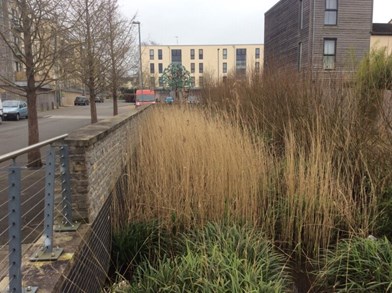 Vegetated rill in new development at Houndswood, Street
Vegetated rill in new development at Houndswood, StreetWhere outline planning has previously been approved, a reserved matters application can be made within three years, to deal with any outstanding details. These details typically include the layout, scale and appearance of the development.
Work cannot begin on site until all reserved matters have been approved.
Any reserved matters relating to SuDS will require information to be provided at the same level of detail as a Full Application. Where all or parts of the SuDS system are to be adopted, approval in writing of the design from the adopting body should be submitted.
Full details of the national and local requirements for reserved matters can be found in the Major Application SuDS Checklist and the Somerset local SuDS standards and accompanying guidance.
Discharge of conditions
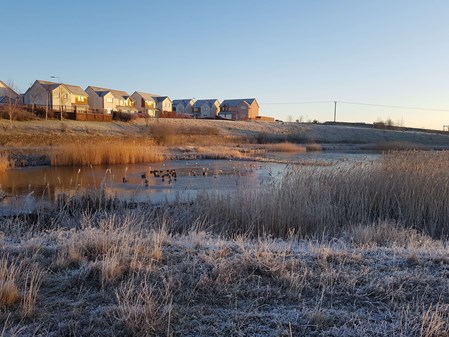 Large landscaped pond in new development
Large landscaped pond in new developmentWhere conditional planning approval has been granted for a site, an application is required to submit further details, to discharge these conditions.
Details requested at the discharge of conditions stage often centre around construction, operation and maintenance of the SuDS network. However, other conditions may be applied depending on the application and the site.
Examples of Discharge of conditions requirements:
- Confirmation of proposed methods for treating surface water runoff (including the first 5mm of rainfall).
- Consent from relevant authority, where connection of discharge to a waterbody/sewer is proposed.
- For phased developments, proposed delivery and construction phasing plans.
- Full construction, operation and maintenance schedules for the proposed SuDS features.
- Documented evidence of confirmed adoption arrangements with the adopting authority.
Where all or parts of the system are to be adopted, approval in writing of the design from the adopting body should be submitted before the discharge of conditions.
Any discharge of conditions relating to SuDS will require information to be provided at the same level of detail as a Full Application.
Full details of the national and local requirements for discharge of conditions can be found in the Major Application SuDS Checklist and the Somerset local SuDS standards and accompanying guidance.
Phased developments
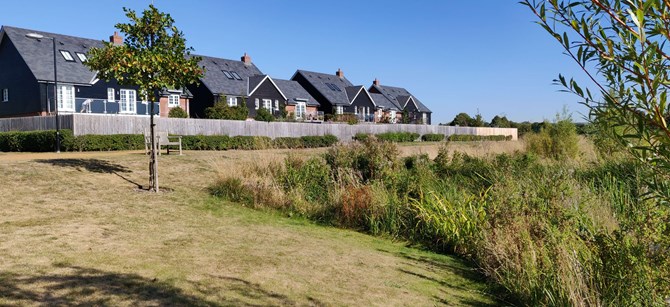 Detention basin in new development
Detention basin in new developmentPhased developments are those which are constructed in several stages, often over many years. This can be a challenge for installing SuDS, as consistency in approach must be maintained from the outline drainage strategy for the entire site to the phase-scale detailed drainage design.
Drainage design for each phase of the development should meet the wider drainage strategy for the whole site, as agreed in the approved outline application. If the drainage design changes between outline approval and the detailed design for a development phase, surface water calculations and drawings will need to be re-submitted for planning approval.
Any changes to the design must not impact on its quality in terms of water quality, climate change, biodiversity, amenity, health and safety, or ease of maintenance (see Somerset Local SuDS standards L10 to L18).
At site-level strategic outline planning stage:
- Details of planned phasing of development, with SuDS in earlier stages of development sized to accommodate later development phases.
- Specified limits to surface water runoff rates and volumes for each phase of development.
- Details on sequencing of SuDS during construction phases, to manage surface water runoff and limit sediment erosion during each development phase (see Somerset SuDS local standard L19).
At phase-scale individual planning application stage:
- Use of surface water runoff rates and volumes agreed at outline planning stage.
- Clear integration of SuDS scheme with the site-wide outline drainage strategy, as well as completed and proposed development phases.
Planning obligations
 Community greenspace
Community greenspacePlanning obligations:
Local authorities can set out the use of SuDS through the Local Plan and policies on how to manage water and drainage according to the characteristics of the administrative area.
The local authority can also utilise a Section 106 Agreement or Community Infrastructure Levy. Both can offset the pressure of a new development upon an existing community where the impact cannot be managed through a planning condition.
Securing SuDS:
The use of planning obligations may be required where SuDS components are not included in the detailed design of a development and sustainable drainage needs to be secured. This way, the use of SuDS can either be set out in a legal agreement or funded as part of the development.
The time to negotiate the content with the developer can delay the planning process. This must be factored in to considerations for whether planning obligations are required or whether SuDS requirements can be resolved through planning conditions.
A Section 106 Agreement is a legally binding agreement between the local authority and the developer, which sets out obligations for the developer to mitigate the impact of a development. Once signed, the agreement is enforceable. This can include obligations to provide public open space, support town centre improvements, and support local health and education.
Community Infrastructure Levy (CIL) is a levy which can be raised by the local authority on new developments to help fund the growing community and its infrastructure.
Check with the Somerset Council Local Planning Authority as to where CIL is applicable to planning applications, and for further details on charges:
- Somerset West and Taunton
- South Somerset
- Sedgemoor
- Mendip - (note, there are currently no CIL charges on development in Mendip)
- Exmoor National Park - (also see policy GP5: Securing Planning Benefits - Planning obligations)

